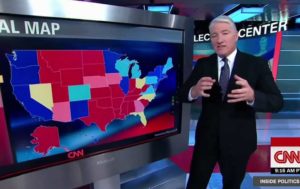Political Competition Hits Historic Low: Part Three
The Electoral College
(This three part series focuses on four foundational election practices that limit political competition and voter choice – methods not meant to be permanent and adopted in the 18th century when democracy was new, populations small, and few candidates or parties or people eligible to vote. Part One looked at Winner-Take-All plurality voting and Partisan Redistricting. Parts Two and Three consider Campaign Finance and the Electoral College.)
 By allowing states and not voters to determine who wins the presidency, the Electoral College plays a unique and powerful role in suppressing political competition. It focuses the election on a handful of battleground states leaving two-thirds of the electorate without a meaningful vote.
By allowing states and not voters to determine who wins the presidency, the Electoral College plays a unique and powerful role in suppressing political competition. It focuses the election on a handful of battleground states leaving two-thirds of the electorate without a meaningful vote.
History
The Electoral College was one of several compromises made to get slave holder states to ratify the constitution. It quickly devolved from its other chief purpose, which was to place the presidency in the hands of august bodies of citizens chosen by state legislatures. By 1836 almost every state had adopted a system whereby they assigned their electors on winner-take-all basis to whoever won their state’s popular vote. Winner-take-all was simple. States thought it gave them more clout in the outcome. It turned out not to except in the case of a few swing state regulars like Ohio and Florida.
Problem
Campaigns determine ahead of time which states are most likely to be battlegrounds and mostly ignore the rest. The large majority of voters are taken for granted. Presidential candidates have little incentive to pay attention to them during and between elections. Take 2016. It saw –
- 143 million voters left on the sidelines – to watch voters in other states make the decision for them.
- Lower voter turnout in non-battleground states – on average five to eight points below those with battleground status.
- Consequently less voting in non-battleground states in other races – for Congress, ballot measures or state legislatures.
- Less personal engagement – the majority of voters never contacted by campaigns about registering or voting.
- More political polarization – as states and voters get divided into red and blue.
Solution – Replace the Electoral College with a National Popular Vote
The National Popular Vote was backed from the beginning by many founders including James Madison. The Electoral College was a stop gap and never intended to be a permanent structure.
Some suggest proportional voting as a solution – allocating electoral votes proportionally based on the vote within the state. This would create competition but lead to other problems like votes being split across multiple candidates contending – often different ones in different state. Another proportional method is used in Maine and Nebraska. They allocate a state’s electoral votes based on its number of congressional districts to the winner of that congressional district. This is actually worse than any other proposal. Congressional districts are easily and commonly gerrymandered to eliminate competition. More than 90% of House seats were not competitive in 2016.
A national popular vote is universal. Every U.S. state or country that directly elects they’re chief executive uses it. Some worry that it might disadvantage voters in smaller states. None of the seven smallest states are competitive or paid any attention to now. The real issue is that the Electoral College today violates the principle of “one person, one vote” and the Constitution’s overall focus on the power of individual citizens or “people”, as well as a “united” not divided states.
How will it change?
One way to change is through a constitutional amendment. Given the difficulty in amending the constitution, a more likely scenario is the National Popular Vote Interstate Compact. This is essentially an agreement among states to assign their electors to the winner of the national popular vote. The Constitution’s Article 2 gives state legislatures control over their electoral votes. If enough state legislatures agree to join the compact and their combined electoral votes add up to 270 or more, the winner in the electoral college will be the winner of the popular vote. 11 states representing 165 electoral votes have already joined. More are considering signing on.
With a national popular vote every vote is sought and competed for. Every voter is sought by candidates and volunteers alike no matter where they reside.
Learn more
The National Popular Vote homepage
The Electoral College: Compromise Never Meant to Last, George Pillsbury, Nonprofit VOTE, 2017
The Real Reason the Electoral College Exists, Paul Reed Amir, Time magazine, 2016




